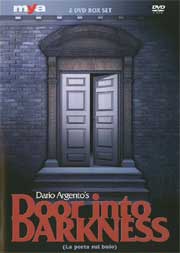 DOOR
INTO DARKNESS (1973)
DOOR
INTO DARKNESS (1973)Director: Luigi Cozzi, Dario Argento, Mario Foglietti
Mya Communication
 DOOR
INTO DARKNESS (1973)
DOOR
INTO DARKNESS (1973)In the early 1970s, RAI (Italy's version of the BBC) attempted to recreate the captivating and successful giallo formula that Dario Argento so masterfully wove in 1970's THE BIRD WITH THE CRYSTAL PLUMAGE. Consisting of four hour long episodes, the limited series is set up in a similar fashion to ALFRED HITCHCOCK PRESENTS and Rod Serling's NIGHT GALLERY, with Dario acting as host, providing an atmospheric introduction before each tale of murder and mystery. Compiling all four episodes, Mya Communication presents DOOR INTO DARKNESS with a two disc set that finally opens the door for Region 1 audiences to explore Argento’s initial foray with the small screen.
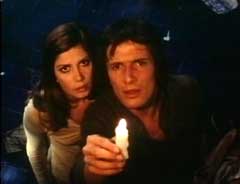
The series kicks off with Luigi Cozzi's The Neighbor (Il vicino di
casa), a Hitchcockian yarn about a young couple who moves into a quaint seaside
villa with their newborn baby, only to uncover that their upstairs neighbor
(Mimmo Palmara) has just killed his wife. Upon their arrival the couple discovers
that the power to their new home has yet to be turned on. Heedlessly, the couple
help themselves to the conveniences of the upstairs apartment, where they stumble
over the lifeless body of their neighbor's spouse on the bathroom floor. With
their car stuck in a ditch, the couple find themselves stranded and alone in
the dark as their neighbor stalks the grounds around them, looking for the perfect
spot in which to dispose of his deader half.
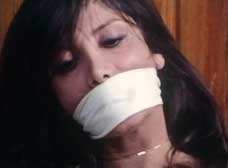 While
the acting is solid, particularly from Mimmo Palmara, the story (simple as it
is) is often too ridiculous to take seriously. What bothered me the most was
how carelessly the couple abandoned their child, either to break into their
neighbor’s apartment or to just stand around and whine at each other for
not being able to push their car back onto the road. Speaking as a parent, if
I were to ever find myself in a similar situation I would have tucked my precious
newborn under my arm and ran down the street like I was being chased by a monkey
with a straight razor the second I had even a minor inclination that my new
flat mate was a killer. Such absences of logic aside, Cozzi does show that he
is more than adept at framing a thriller, thankfully finding a much more proper
and intriguing tale to tell in 1975 with THE KILLER MUST KILL AGAIN.
While
the acting is solid, particularly from Mimmo Palmara, the story (simple as it
is) is often too ridiculous to take seriously. What bothered me the most was
how carelessly the couple abandoned their child, either to break into their
neighbor’s apartment or to just stand around and whine at each other for
not being able to push their car back onto the road. Speaking as a parent, if
I were to ever find myself in a similar situation I would have tucked my precious
newborn under my arm and ran down the street like I was being chased by a monkey
with a straight razor the second I had even a minor inclination that my new
flat mate was a killer. Such absences of logic aside, Cozzi does show that he
is more than adept at framing a thriller, thankfully finding a much more proper
and intriguing tale to tell in 1975 with THE KILLER MUST KILL AGAIN.

Episode Two, The Tram (Il tram) was written and directed by Argento under the pseudonym Sirio Bernadotte and features Enzo Cerusico as a police investigator faced with a particularly perplexing puzzle. Inside a crowded city tram, a beautiful young woman is stabbed to death, yet there are no witnesses to the crime. With numerous colorful suspects to choose from, the detective attempts to recreate the crime by gathering the following evening’s passengers together for a joyride down the same route, hoping that the killer's identity will present itself before the last stop. As each passenger boards and exits the tram in the same order as the previous night, it is the tram’s ticket taker that becomes suspect numero uno. Unconvinced that the tram’s attendant is indeed capable of murder, the detective again takes to the city’s trains, this time dragging his girlfriend along in an attempt to wrap his mind around the baffling case, unknowingly putting them both in the path of the real killer.
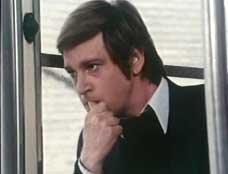 While
you can certainly feel Argento’s hand guiding The Tram along a somewhat
familiar but all together satisfying route, the picture feels edited and subdued.
This is undoubtedly due to the heavy restrictions put upon the series by the
RAI. Save for a fleeting shot of a pair of black gloves (seen in the third entry,
Eyewitness) the series as a whole has more in kin with MURDER SHE WROTE than
it does with the often sexually driven gialli from which the series originally
drew its inspiration. Argento does however keep things interesting with several
doses of dark humor and a handful of one-liners in which to fill the holes left
by the lack of bloodshed and nudity.
While
you can certainly feel Argento’s hand guiding The Tram along a somewhat
familiar but all together satisfying route, the picture feels edited and subdued.
This is undoubtedly due to the heavy restrictions put upon the series by the
RAI. Save for a fleeting shot of a pair of black gloves (seen in the third entry,
Eyewitness) the series as a whole has more in kin with MURDER SHE WROTE than
it does with the often sexually driven gialli from which the series originally
drew its inspiration. Argento does however keep things interesting with several
doses of dark humor and a handful of one-liners in which to fill the holes left
by the lack of bloodshed and nudity.
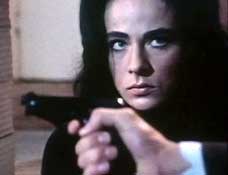
A mysterious killer, a missing body, a woman on the brink of a nervous breakdown and a police inspector who arrives just in time to wrap everything up in nice, tidy ball; of all of the episodes, Eyewitness (Testimone oculare) feels the most comfortable in the realm of the gaillo. Roberta (Marilù Tolo, ROY COLT AND WINCHESTER JACK) is driving home late one night, when she almost hits a woman while speeding around a sharp curve. Stopping abruptly, she jumps out to find a lady bleeding in the middle of the road, yet her car never made any impact with the passed out woman. Already distressed, Roberta's night is sent into a panic when she catches a glimpse of a shadowy assailant on the other side of the road. Rushing to a nearby pub, Roberta contacts the police, but further investigation of the curve in the road proves no body and no trace of blood. With the local police inspector (Glauco Onorato, THE BIG RACKET) reluctant in taking her story seriously, Roberta returns home with her husband (Riccardo Salvino, EMANUELLE IN AMERICA) and attempts to return to her normal life, but she just can’t shake the feeling that her life is in danger and that the shadowy figure on the other side of the road has one more loose end that has yet to be tied. While Roberto Pariante is listed as director for this episode, it is Argento who should actually get the credit. Based off a script by Argento and Cozzi, Argento was so displeased with Roberto’s finished product that he re-shot the story himself, resulting in what is arguably the series' strongest episode.
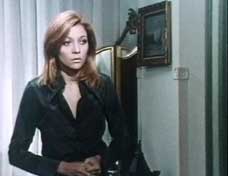 The
series final episode, The Doll (La bambola) directed by Mario Foglietti, is
also its weakest, providing little more than a bit of eye candy in the shapely
form of Erika Blanc (KILL BABY, KILL) and Mara Venier. After a lunatic escapes
from an insane asylum, red heads all over Italy are put on alert, as the psychopath
strikes down a beautiful crimson haired beauty (Blanc) within hours of his not
so daring, actually quite boring escape. The first half of this episode feels
as if it’s just running through the motions in order to fill the required
50 plus minute timeslot. There are actually several minutes solely devoted to
characters walking down the street. The only thing more boring than taping someone
walking down the street has to be watching the tape that was shot of someone
walking down the street. When the episode does begin to pick up, it’s
far too late as most of its cards have already been shown, leaving the big reveal
of the killer's identity a disappointment.
The
series final episode, The Doll (La bambola) directed by Mario Foglietti, is
also its weakest, providing little more than a bit of eye candy in the shapely
form of Erika Blanc (KILL BABY, KILL) and Mara Venier. After a lunatic escapes
from an insane asylum, red heads all over Italy are put on alert, as the psychopath
strikes down a beautiful crimson haired beauty (Blanc) within hours of his not
so daring, actually quite boring escape. The first half of this episode feels
as if it’s just running through the motions in order to fill the required
50 plus minute timeslot. There are actually several minutes solely devoted to
characters walking down the street. The only thing more boring than taping someone
walking down the street has to be watching the tape that was shot of someone
walking down the street. When the episode does begin to pick up, it’s
far too late as most of its cards have already been shown, leaving the big reveal
of the killer's identity a disappointment.
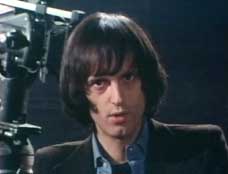 Fans
of Argento have been teased with the prospect of an official U.S. release for
DOOR INTO DARKNESS before, most recently by NoShame Films who taunted fans with
an April release last year before mysteriously closing up shop. Thankfully,
Mya Communications has stepped up to fill the void left on many a fan's wish
list. All four episodes are presented full frame in their original 1.33:1 aspect
ratio and feature a disclaimer that states that since the original film elements
no longer exist, all transfers were taken from the RAI TV video masters. The
result is a less than pristine image but beggars can’t be choosers. Often
hazy, with muted colors, each episode has its high and low marks in term of
quality, but all in all, the picture is acceptable given that Mya Communication’s
options of source material were limited. Audio is on hand in an Italian language
mono mix that features clear dialogue and little in the way of distortion, accompanied
by optional English subtitles. If you already own the German release of DOOR
INTO DARKNESS, released by Dragon in 2004, and you are wondering if Mya’s
latest is worth the upgrade, Disc Two's single supplementary feature should
cast aside any doubt about double dipping. DARIO ARGENTO – MASTER OF HORROR
is a feature length documentary directed by Luigi Cozzi that features an in-depth,
on the set look into the Euro Cult director’s dark vision. While short
on narration, the documentary provides several extended behind the scenes peaks
of Argento at work, paying particular focus on TWO EVIL EYES, OPERA and PHENOMENA
(aka CREEPERS). Featuring over 5 hours of mirth and mayhem from one of horror’s
leading visionaries, Mya Communication’s has finally filled the hole in
the Argento section of my DVD library and I for one am quite thankful. (Jason
McElreath)
Fans
of Argento have been teased with the prospect of an official U.S. release for
DOOR INTO DARKNESS before, most recently by NoShame Films who taunted fans with
an April release last year before mysteriously closing up shop. Thankfully,
Mya Communications has stepped up to fill the void left on many a fan's wish
list. All four episodes are presented full frame in their original 1.33:1 aspect
ratio and feature a disclaimer that states that since the original film elements
no longer exist, all transfers were taken from the RAI TV video masters. The
result is a less than pristine image but beggars can’t be choosers. Often
hazy, with muted colors, each episode has its high and low marks in term of
quality, but all in all, the picture is acceptable given that Mya Communication’s
options of source material were limited. Audio is on hand in an Italian language
mono mix that features clear dialogue and little in the way of distortion, accompanied
by optional English subtitles. If you already own the German release of DOOR
INTO DARKNESS, released by Dragon in 2004, and you are wondering if Mya’s
latest is worth the upgrade, Disc Two's single supplementary feature should
cast aside any doubt about double dipping. DARIO ARGENTO – MASTER OF HORROR
is a feature length documentary directed by Luigi Cozzi that features an in-depth,
on the set look into the Euro Cult director’s dark vision. While short
on narration, the documentary provides several extended behind the scenes peaks
of Argento at work, paying particular focus on TWO EVIL EYES, OPERA and PHENOMENA
(aka CREEPERS). Featuring over 5 hours of mirth and mayhem from one of horror’s
leading visionaries, Mya Communication’s has finally filled the hole in
the Argento section of my DVD library and I for one am quite thankful. (Jason
McElreath)